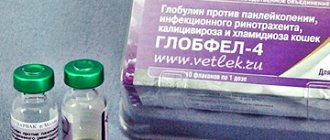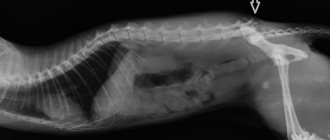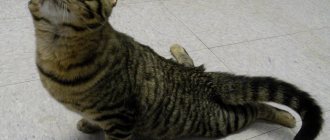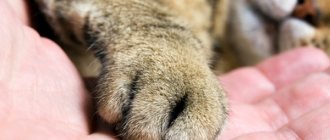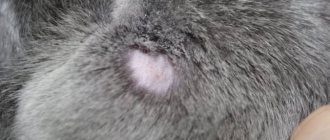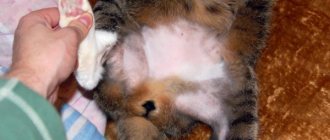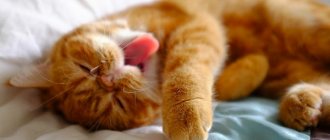The cold paws of a cat who has just returned from a walk should not bother us. However, if this condition persists, you should pay attention to the cat's health.
When your cat jumps on your lap, you may feel a piercing cold from time to time. This may seem strange since cats have a higher body temperature than humans. So where did these ice pads come from? Is there a reason to worry when your cat's paws are cold?
What are the normal paws of a cat?
It is quite difficult to answer this question with utmost accuracy, since the cat’s body temperature also changes during the day. This is a completely normal physiological scene. Domestic cats have soft paw pads with good sensitivity. The yard scratch has rougher pads. This causes low vulnerability of nerve endings to the outside temperature.
If we compare the temperature numbers of the pads with the temperature of the rest of the body, then they are somewhat further than on its surface. But at the same time they are higher than the outside air temperature. A similar picture is observed almost all day long. After all, most of the day (18 hours) cats sleep or doze. You should not equate sleep with napping, during which the animal simply rests. But in a state of sleep, the cat’s device relaxes as much as possible. At this time, one can observe the primacy of the processes of inhibition of higher nervous activity, a significant decrease in metabolic processes against the background of activation of the immune system.
It is known that immunity can influence the basic body temperature. This explains that in a dream there is some increase in it. This phenomenon fits within the physiological norm.
Important!
If the cat's temperature decreases not only in its paws, but also in its entire body, this is a reason to contact a veterinarian. There can be quite a lot of reasons for this and only a doctor can determine it.
Why does the kitten have a hot nose?
Cats are quite frost-resistant animals.
Long-haired breeds can withstand frosts down to minus 30 degrees. If the cat is cold at room temperature, then there is cause for concern. The consequences of lowering the temperature can be irreversible and even lead to death.
If your cat is cold, look for the following signs:
- the animal lies down in a warm place;
- chills, trembling;
- lethargy;
- pallor of the mucous membranes.
If these signs appear, take your pet's temperature. If it is below 36 degrees, the cat is cold in the abdominal area, you need to contact a veterinarian, otherwise the animal may fall into a coma.
- bleeding;
- diseases of the cardiovascular and nervous systems;
- viral or infectious diseases;
- general weakening of the body.
Before he arrives, wrap your pet in a blanket and give him a warm drink.
Kittens are very playful and active, they run, jump and play a lot. Because of this, it often happens that a kitten has a hot nose, and this is not at all a cause for concern. If you notice that his nose remains dry throughout the day, it’s time to start sounding the alarm. As a rule, in this case, on the second day, discharge appears from the nose - colorless or purulent.
If the cat has a hot nose and paw pads, and you do not have the opportunity to show your pet to a veterinarian, you can independently provide him with all possible help. Without harm to health, you can give it to a cat for children. A kitten can be given 1/6 of the tablet, an adult cat - 1/4 or 1/2. This drug is a good immunostimulant and has anti-inflammatory and antiviral effects. If you urgently need to reduce the temperature, you need to give an injection into the withers by adding 0.2 ml of no-shpu, analgin and diphenhydramine to the spitz.
A hot nose in a cat can be a symptom not only of a cold, but also of a more serious illness, so at the first opportunity it is better to show the animal to a veterinarian for tests and clarification of the diagnosis. Remember that with a prolonged increase in temperature, the body experiences dehydration, which can lead to weakness and death.
A loving owner always pays great attention to the condition of his pet and, if necessary, is ready to begin treatment in a timely manner. Sometimes, noticing that a cat has hot paws, as well as a nose and ear, a person begins to seriously worry, trying to find an explanation for this phenomenon. Most often, such a condition of a cat should not cause concern, as it is explained by natural causes. It is also worth remembering that a cat’s temperature is higher than a person’s.
Cats are quite frost-resistant animals. Long-haired breeds can withstand frosts down to minus 30 degrees. If the cat is cold at room temperature, then there is cause for concern.
Causes of no concern
The animal body, that is, the human body, is characterized by the presence of thermoregulation. Suitable at a very young age. Ant. its imperfection cannot be observed, and in older cats its function is weakened. During periods of scale, it normally functions in a way that cannot be helped. Measures to correct it are usually not required. Thermoregulation is influenced by the speed of metabolic processes occurring in the body. As the breakdown of carbohydrates increases, the body's liquidus also increases.
The temperature indicators are also affected by the microclimate of the room in which the beloved is located. If it is cold where the cat is, then the temperature of its paws will drop.
Important! Breeds of cats whose pycnidia are devoid of hair cannot effectively protect the processes of normal thermoregulation. Where the cat is in its natural environment, in life) there are no negative temperatures. Therefore, such cats in a warm apartment need some kind of clothing.
Maybe the situation is the opposite. Excessive heat in the room and intense physical activity can cause the cat's paw pads to become cold. To this day this is understandable. The fact is that between the toes and paws of a cat there are sweat glands. Simply put, the bitch sweats due to her paws. Intense sweat leads to cooling of the pads.
If an animal has long hair, this phenomenon will only go away unnoticed. Sweat settles on the fur and does not cause cooling.
Possible ailments
Cold extremities can indicate a number of ailments that may occur slowly or even unnoticeably. To compile an anamnesis, you need to observe your pet for 3-4 days, recording changes in the temperature of the paws.
Cooling of the extremities after or after use for other purposes is considered an absolutely normal phenomenon. Narcosis is a drug and the body is in a state of severe intoxication. Reduced body temperature protects the brain from the harmful effects of the chemical components of the drug. Even in the summer, after anesthesia, it is recommended to keep the cat on a heating pad until it comes to its senses and goes to a cooler place.
For any cat owner, the health of their beloved pet always comes first. At any slight hint of malaise, the owner becomes worried and worried. After all, animals cannot tell what and where it hurts, even if they feel very bad. The first thing everyone without exception does when they suspect something is to touch the noses of their cats.
Sensitive owners always closely monitor the behavior of animals. And this is correct, since behavior is a direct indication of well-being. And if the nose is hot, and the cat is lethargic, refuses to eat, does not want to play, and lies down most of the time, this is already a reason to be seriously wary. If, with a hot nose, the fluffy is cheerful, cheerful, playful, and demonstrates an excellent appetite, you can relax. Why do cats have hot ears? In what cases is this the norm, and in what cases is it a dangerous signal. Any owner needs to clearly define this.
If a cat's hind legs fail, the cause can only be pathological. It occurs as a result of disorders of the cardiovascular system, the functionality of the brain and the musculoskeletal system.
Intervertebral hernia is the cause of osteochondrosis, which manifests itself in cats after the age of eight. During this period, active aging of the body begins, leading to a decrease in the functionality of the musculoskeletal system. As a result, a protrusion of the intervertebral disc forms between the vertebral bodies.
Mobility device
If a cat loses its hind legs, the pathology is accompanied by the following symptoms:
- acute pain, due to which the cat constantly meows, becomes weak, lethargic, and moves little;
- periodic formation of involuntary muscle tone and tension;
- in the affected areas of the body, mobility is reduced or absent;
- poor appetite, the cat may completely refuse to eat;
- possible dyspeptic disorders, symptoms of ulcers or pancreatitis;
- the body has a characteristic pose, the animal moves strangely, and can only use its front legs to do this.
Inflammation of the spinal cord most often occurs due to the penetration of a bacterial infection or viral agent. Initially, the pathogen spreads through the blood-brain barrier, as it is small in size. It enters the brain, through which it penetrates into the cerebrospinal fluid.
READ Milbemax dosage for cats
Acute inflammation occurs, accompanied by the following symptoms:
- the animal constantly feels sick, vomits at any time, regardless of food intake;
- unsteady gait;
- acute pain throughout the body, the animal lies down and is unable to move;
- behavior changes, the pet may be overly aggressive and not recognize its owners;
- Gradually, due to refusal of food, the body becomes depleted; without antibacterial therapy, the pet dies.
Important! Diseases of the central nervous system and peripheral nervous system are dangerous and rarely result in recovery. They are difficult to suspect in the early period, so the veterinarian often has to treat complications.
If the animal's blood vessels are prone to developing an inflammatory reaction or the blood coagulation system is overactive, blood clots may form. They come in large and small sizes. Even a slightly small blood clot can cause harm by clogging a capillary. If large blood clots form, they are able to resist the blood flow of the largest arteries that supply blood to the spine and lower extremities.
The cat's hind limbs may be paralyzed. Symptoms develop instantly:
- hind legs drag along the floor;
- the animal becomes restless, its behavior changes sharply;
- The forelimbs may gradually fail, leading to complete paralysis.
You can save your pet only by urgently contacting a veterinarian. But in most cases there is not enough time.
The pathological process occurs in kittens immediately after birth. The condition is characterized by the following symptoms:
- the hind legs are not able to hold on, they move apart;
- when walking, the cat may drag its legs;
- Without help, the problem does not go away, but gets worse.
The cause of the pathology is the incorrect formation of the hip joint. If a cat has a multiple pregnancy, with more than 5 kittens, this is fraught with their low mobility in the uterus. If the hip joints do not move, they develop incorrectly.
Tick paralysis
If the owner of a cat periodically walks him outside, he should be wary of the spring and summer periods. At this time, ticks actively reproduce and bite cats and dogs. Not all ticks carry the infection, but some of them transmit toxins into the blood, causing neurological disorders.
Hip dysplasia in a kitten
Tick-borne encephalitis or meningitis leads to inflammation of the brain, neurological reactions, which cause severe paralysis. The condition is aggravated by profuse vomiting, a sharp increase in body temperature, and complete refusal to eat.
As toxins spread through the blood, internal organ failure occurs, with a gradual loss of functionality. The animal dies without the use of medications against tick toxins.
Stroke
Stroke in a cat can be of the following types:
- ischemic – narrowing of the vessel wall with the development of hypoxia and necrosis of brain tissue;
- hemorrhagic - damage to the wall of a cerebral vessel with the formation of hemorrhage.
If the part of the central nervous system responsible for the lower extremities is damaged, initially the legs begin to braid, then their function is completely disabled. It is possible to repair such damage in rare cases.
Spinal injuries
Cats generally love heights. But this often leads to them falling, resulting in spinal damage. If the lower area is damaged, the hind legs immediately fail. It is impossible to do anything about this condition. The doctor may try to make a special device for the cat, thanks to which it can move on its front legs.
Cardiomyopathy
All organs function thanks to normal blood supply. To deliver blood, normal functioning of the myocardium of the heart muscle is necessary. If an animal develops cardiomyopathy, this section does not function sufficiently. As a result, it is difficult for blood to be delivered to the lower extremities. First, the cat begins to drag its legs, then cannot move with them.
Thanks to the intake of vitamins and microelements, a certain metabolism is formed in the cat’s body. With its help, the cellular composition is updated, the functionality of absolutely all cells occurs.
Vitamin deficiency is a condition of a sharp decrease in all types of vitamins. This is typical for pets that are fed monotonous food that does not contain nutrients. As a result, general weakness occurs and the legs become weak when walking. A common occurrence is the development of seizures, that is, muscle twitching.
Important! If a cat develops kidney failure, its filtration capacity is impaired. All substances are actively released from the body without being absorbed back. Therefore, the same reactions occur as with vitamin deficiency.
This is a disease accompanied by the sudden formation of blood clots that block an area of the spinal cord. If the area in the lumbar region is affected, it is the hind legs that stop functioning. The cat is unable to walk. The condition is accompanied by severe pain, so she begins to scream.
Brain inflammation
Not only the spinal cord can become inflamed, but also the brain. This condition is called encephalitis, meningitis. Most often it develops against the background of viruses and infections. They damage neurons, causing an acute inflammatory reaction.
Cerebral edema develops with the following clinical condition:
- sudden and profuse vomiting begins;
- the legs give way, the cat falls, unable to rise;
- body temperature rises;
- if the respiratory center is involved in the process, the pet is not able to breathe.
If the condition develops in a kitten, its immune system is not able to cope with the condition. He quickly dies. Adults have a better chance of surviving with timely treatment.
Hyperparathyroidism
Hyperparathyroidism is a disease of the parathyroid gland that causes increased secretion of parathyroid hormone. As a result, the metabolism of calcium and phosphorus accelerates and the function of the musculoskeletal system is disrupted. Bone mass decreases, resulting in increased fragility and decreased functionality. Both the front and hind legs may be amputated.
What should you do to warm your cat's paws?
First of all, you should determine the cat's base body temperature. (otherwise the cat’s paws remain cold at normal levels, so you need to try to warm them up. You need to determine how hot the cat is in the room where she is. This can be done by monitoring the pet’s behavior:
- The cat can scratch on the floor or selectively move along the top. In the second case, we can conclude that the cat’s gender is not warm enough. After all, the higher you go, the warmer the climate.
- If there is a sharp cold snap, and the cat shed the day before, this may cause her paws to become cold. Whatever you say, it is not the fur that warms the cat, but the undercoat.
- You can observe that sometimes a cat persistently asks to go to bed with its owner. This indicates that the pet is looking for additional sources of heat.
The most optimal action in this case is to insulate the cat’s house with a warm substrate. Now they have begun to give (transfer) to whose will (at whose discretion) to make it a heat-insulating sheet. Outwardly, it is not very presentable, but the cat will be warm and comfortable in such a house. When a cat sleeps in its house, its heat output is increased. If it's cold in her home, she may freeze in her sleep.
Why do my ears get warm?
Most often, hot ears in a cat do not indicate significant health problems. After all, it is known that these animals are big fans of lying in the sun or sitting on a hot radiator.
If after such a pastime you notice dryness and warming of the ears and nose, you should not think about illness. However, you need to know in what situations you should run to a specialist.
Infection;
Inflammation;
Gastrointestinal diseases;
Bladder stones.
When paying attention to warming of the ears, you need to first examine the auricles - sometimes this symptom indicates an infection with ear mites. If lumps of dirt or crusts are observed, you need to prepare to treat the animal.
Stress and excitement are often the cause of a rise in temperature in a cat. Experiences contribute to increased heart rate, resulting in an increase in temperature, causing a symptom that frightens the owners.
Infection;
Inflammation;
Gastrointestinal diseases;
Infection;
Inflammation;
Gastrointestinal diseases;
Pathological conditions as a cause of cold paws
If a cat has cold paws, this may indicate the presence of a number of pathological conditions that may not even manifest themselves exogenously. A similar phenomenon can occur when a cat is poisoned with various poisons. A pet can also be poisoned by decay products in the body, which can be observed, for example, with diabetes, hormonal disorders and or - or pathology associated with metabolic processes.
There may be problems associated with impaired absorption of food. If your pet has lost weight and has cold extremities, then this is a reason for someone to go to a veterinary clinic to donate blood for testing. The cause may also be anemia, which can be determined by the decrease. Other formed elements, on the contrary, can be increased. For example, an increase in platelets leads to a deterioration in blood flow, and this can cause cold paws in a cat. Older cats are especially susceptible to this.
The reason why a cat's paws become cold may be internal metropathy, painful traumatic shock, or a condition associated with severe dehydration. Finally, this condition can be caused by cardiac dysfunction.
To this day, this is a reason to immediately visit a veterinarian. Only the devil can make the correct diagnosis and prescribe appropriate therapeutic and corrective measures.
Symptoms of hind leg failure
Often, when there are problems with the limbs, the cat's behavior changes. She moves less, lies down more, stretching out her hind legs, and refuses to play. When your pet gets up to go to the toilet or eat, you may notice changes in gait. The animal walks slowly and uncertainly, wags its hind end strangely, and often crouches down to rest.
Cold paws in a cat are an insidious symptom of diseases that occur almost unnoticeably. To understand whether a pet is sick or not, you need to observe the condition of its limbs for several days. It is necessary to remember when, at what time of day, a change in temperature is observed, what else happens, perhaps these will be other hidden signs of the disease.
We suggest you read: What to do if your cat has red urine
The paws of animals become cold after surgery using anesthesia. For example, sterilization. During anesthesia, the body protects itself from its harmful effects on the brain by lowering the overall body temperature. Therefore, it is necessary to use a heating pad after surgery, when the animal recovers from anesthesia. Moreover, this is done regardless of the time of year and weather, even in the heat.
Causes a decrease in temperature and various poisonings. Usually, several characteristic symptoms are observed here at once - vomiting, diarrhea, mucous membranes lighten, and salivation begins. Moreover, poisoning occurs not only with chemicals, but also with internal diseases, when the body is intoxicated with decay products, metabolic processes are disrupted.
Cold and hot
The temperature of an animal's ears can depend on many factors and does not necessarily indicate that some negative processes are occurring inside the body. The reasons may be the following:
- the cat does not have enough warmth, that is, speaking in natural language, it is freezing, so it tries to lean its body against a person or some warm object in order to warm up;
- Cold ears in cats can also occur when the animal is pregnant and this is one of the manifestations of toxicosis, which also occurs in cats; in this sense, they are not too different from humans;
- Cold ears are also one of the signs of a disease that can even lead to the death of a pet.
© shutterstock
In any case, a cat's ears are an indicator of an internal state that you need to pay attention to. But remember that even when a cat has cold paws and ears, this is not necessarily a negative characteristic of the animal’s general condition.
The tips of the ears are cool according to the general physiology of these pets, since it is in these places that the smallest number of blood vessels are concentrated. In addition, the ears are covered with sparse hair, so they become a natural zone for the release of internal heat.
